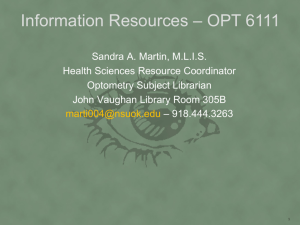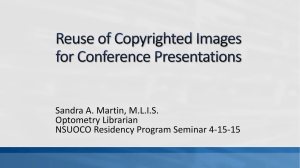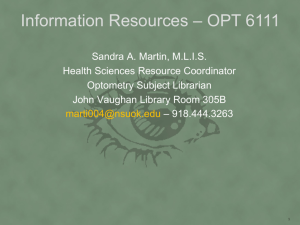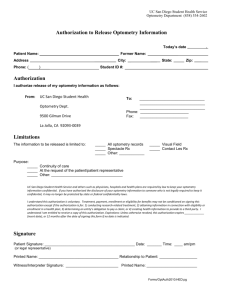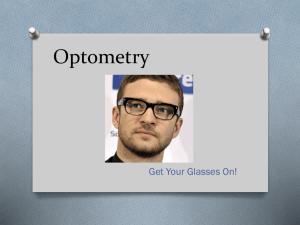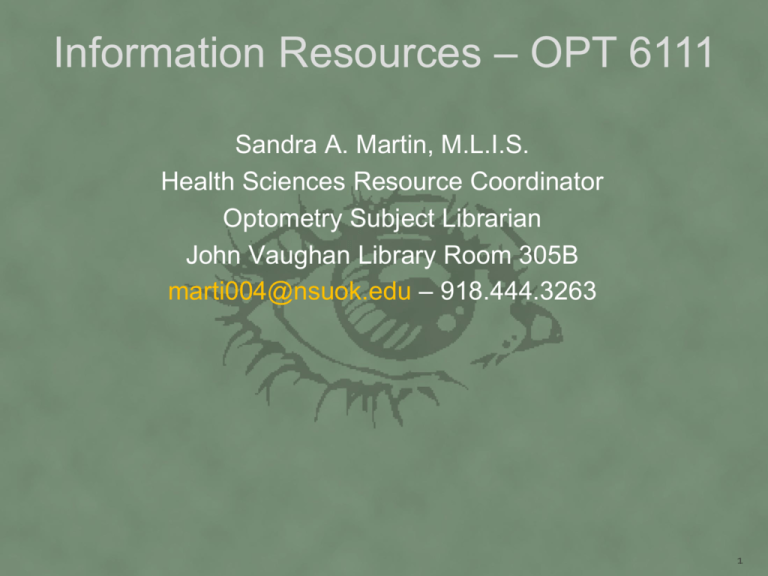
Information Resources – OPT 6111
Sandra A. Martin, M.L.I.S.
Health Sciences Resource Coordinator
Optometry Subject Librarian
John Vaughan Library Room 305B
marti004@nsuok.edu – 918.444.3263
1
Learning Objectives
•
•
•
To provide a mechanism for students to access
the most current vision science and medically
related information
To familiarize students with specific information
resources and library services to support the
literature review required for OPT 6111 and
6121
To familiarize students with evidence-based eye
care and life-long learning techniques
2
John Vaughan Library (JVL)
Short walk from the Optometry building
Comprehensive print and online collections
Friendly, welcoming staff
Open until 12:00 a.m. Sunday-Thursday during Fall and
Spring semesters
Hours posted at
http://library.nsuok.edu/Admin/libhrs.html
Checkout Laptops, iPads, & cameras at Reserve Desk
Wi Fi hot spots throughout the building
Comfortable seating and study environments
3
Services and Collections
1st Floor – Reserves, Audiovisuals, Circulation,
Interlibrary Loan, Computers, Scanners & Printers
2d Floor – Journals, Newspapers, Special Collections,
Computers, Scanners & Printers
3d Floor – Books, Government Documents, Optometry
Librarian (305B)
Books & Journals shelved by Library of Congress call
numbers. Most Vision Science titles found in R, RE, and
Q areas
4
Sandra Martin Provides….
Instruction
Research Assistance
Small Group Consulting
Database Searches
Collection Development (Selection of print and online
books, audiovisuals, journals and databases)
Assistance with any health-related information need
Office Hours: Tuesday 10 am to 4 pm
6
Helpful Tools
Optometry Web Page
Optometry Databases, e-journals, e-books, and other tools
available 24/7
Supports specific research, teaching, and patient care needs of
NSUOCO faculty, students, and residents
Start Here to find resources for all optometry and medical topics
http://library.nsuok.edu/collegeop/index.html
Important Link: Instructions for Locating Full Text
Journal Articles shows you how to find full text of
articles available in “all” library databases
Instructions for Locating Full Text Journal
Articles
Link From the NSU Libraries Home Page
11
Remote Access
Enter NT-NSU user id and password to access the
library’s electronic resources
Contact Tom Tinnell if you have problems with your user
id or password
Contact Sandra to report other technical problems or for
search assistance
12
Interlibrary Loan/Document Delivery
Services
ILL Requests
Scan and email pdf of articles from journals in the library’s
print collection – you do not have to pull print journals from
the shelf and scan or photocopy
Deliver books, audiovisuals, and journal articles not owned
by the library
Journal articles delivered electronically if possible
Click on Interlibrary Loan link from Optometry Web Page
Create the online Iliad Profile
Complete online request form for articles and books
Contact ill@nsuok.edu for help
13
Information Retrieval to conduct Research
Comprehensive in scope and time
All levels of resources
Current and Retrospective
Background and Foreground Information
14
Match Resource to Information Need
What is the question?
How will information be used?
15
Background vs. Foreground Questions
Asking questions about your proposed topic
helps to clarify your knowledge gap
Clarifying type of question helps to determine
which sources are most likely to have the
answers you need
16
Background Questions
Generally ask who, what, why, where or how
about a single concept
Require general knowledge of disease and
therapeutic processes
17
Proposed Research Projects
Evaluate the accuracy of the Humphrey
Visual Field Analyzer compared to the MP-1
in patients with glaucoma
Assess efficacy of anti-fatigue lenses in
relieving eye strain and computer vision
syndrome
Assess effectiveness of vitamin supplements
and oral antioxidants to improve dry eye
symptoms
18
Begin with Background Questions
What are methods of visual field testing in
glaucoma? How is the Humphrey Visual
Field Analyzer used?
What are the ocular causes and potential
treatments of visual fatigue and computer
vision syndrome?
What oral antioxidant combinations and
topical vitamin eye drops have been used to
treat dry eyes in adult patients?
19
Answers to Background Questions
Resources:
Clinical Key
e-Book and e-Journal Collections
Print Books
Ovid MEDLINE – Basic Search
Visionet – vision therapy related topics
20
Clinical Key
Full text access to 1,000 books and 500 journals in every
medical and surgical specialty
Ophthalmology – Over 60 full text books
Includes 12 Content Types
Access to information at all levels from topic overview to
evidence-based data in one search
Smart search engine matches first few letters of search
word/words to relevant clinical content
No complicated search strategies or Boolean connectors
Easier than Google – but with reliable, evidence-based
results
Ovid MEDLINE- Basic Search
U. S. National Library of Medicine’s premier database.
Contains over 20 million citations to journal articles in
medicine, nursing, allied health, and basic sciences as
they relate to health care
OvidSP software provides useful tools to filter search
results and target information for precise needs
Begin with “Basic Search”
Contains links to full text of major vision science journals
in NSU libraries subscriptions and open access sources
NOTE: PubMed (free MEDLINE) contains links to “open
access” (free) full text but NOT to NSU subscriptions
22
Visionet – produced by SCO
Citations to articles in Optometry journals not found in
MEDLINE
Especially useful for articles on vision therapy, visual
training, vision screening, low vision, practice
management, etc.
Contact Sandra for help
23
Major e-Book Publishers
Elsevier and Subsidiaries: Clinical Key, Science Direct
Lippincott, Williams & Wilkins: Books@Ovid
Slack and Springer Science: R2 Digital Library
McGraw Hill – Access Medicine
24
Drug Monographs
Full-text monographs for all FDA approved drugs:
Clinical Key, Access Medicine, UptoDate
Include information for the health care professional and
the patient
Search by generic or brand name
Include sections on indications, contraindications, handy
tools, calculators, and tables
25
Print Book Collection
John Vaughan Library, 3rd Floor
Comprehensive collection
Meets Association of Vision Science Libraries standards for core
collection
Largest Optometry/Ophthalmology book collection in the region
Search NSU libraries “Catalog: Books & More” link
26
Additional Background Resources
Frequently used e-Journals
Web Portals
Optometry and Vision Science
JAMA Ophthalmology
JAMA
New England Journal of Medicine
Investigative Ophthalmology & Visual Science
ARVO Journals
Healio Optometry
Open Access Ophthalmology Journals
Link to these titles directly from Optometry web page
27
Sandra A. Martin, M.L.I.S.
Optometry Librarian
NSUOCO Residency Program Seminar 4-15-15
Guidelines for reuse of images, under “fair use”
provisions of Copyright Law, obtained from
online resources licensed to NSU Libraries
Guidelines for securing permissions from
copyright holders to reuse content beyond
simple educational reuse (republication,
presentations for commercial entities, etc.)
Links provided at
http://library.nsuok.edu/collegeop/index.html
Elsevier – Clinical Key and Science Direct
Wolters Kluwer – UpToDate and Ovid Products
McGraw Hill – Access Medicine
R2 Digital Library
Copyright Law
Legal or prescriptive advice
Use of images outside “fair use” guidelines
Use of images obtained from other resources
Examples of academic Copyright Information
Centers that provide services and policies for
faculty and students
Cornell University
http://copyright.cornell.edu/services/#forms
Brigham Young University
http://sites.lib.byu.edu/copyright/
Fair Use
Permissions
Forms
Tutorials
Cases
Guidelines
Legal Issues in Education web page
http://academics.nsuok.edu/teachingandlearni
ng/TLResources/LegalIssues.aspx
Provides links to other web pages
Does not include specific policies/guidelines for
NSU faculty and students
Copyright
protection provided by law (17, U.S. Code §102) to the
authors/creators of “original works of authorship,”
expressed in a tangible medium
Examples of protected works
Intellectual property, such as literary, musical, dramatic,
graphic, audiovisual works, etc.
Educational activities involving copyrighted works
Research projects, journal articles, books, videos,
lectures, concerts, plays, speeches, presentations, etc.
An exemption that allows “limited” use of
copyrighted material without permission from
the copyright holder for criticism, comment,
teaching, research, and scholarship
Must include a copyright notice
Must include four factors
http://www.pacificu.edu/sites/default/files/documents/FairUseChecklist.pdf
Purpose
Nature
Effect
Portion
Purpose - Nonprofit educational vs. commercial
for profit
Nature – Published, Factual vs. unpublished,
creative
Portion – Small quantity vs. entire work
Effect – Lawfully owned vs. replacing sale of
copyrighted work
Pacific University Oregon
http://www.pacificu.edu/facultystaff/documentation-and-forms/copyrightbasics/copyright-usage-guidelines
Intended to help you determine whether or not
use qualifies as Fair Use
Organized in Three Use Categories:
Safest
Questionable
Dangerous
Nonprofit educational conferences – NSUOCO
Continuing Education Symposium, AAO, OAOP
Educational and clinical settings – lectures,
journal clubs, informing patients, etc.
Sharing with colleagues – email or print
Exported from lawfully acquired online source
Personal
Subscription
NSU
Subscription
See Publishers’
Online Policies
Posting to conference web site
Publication in conference proceedings
Sharing print or email copies with attendees
Sharing at paid speaking engagements
Request
Permission
Publishers
Third Party
Login to CK personal account
Limit search to Multimedia – Images
Save Image to your Presentations
Open Presentation and Export image to
PowerPoint
Exports image along with copyright information
Non-commercial reuse in educational settings
Chronic atypical central serous chorioretinopathy in a 53-year-old woman with pigment epithelium detachment first examined in 2000. (Upper left) Color fundus pho
showing a yellow spot temporal to the fovea. (Upper right) On the early phase of fluorescein angiography (FA), this yellow spot corresponds to a deep hypofluoresc
left) At the late phase of FA, mild leakage temporal to the fovea and partial staining of an inferomacular serous retinal detachment (SRD). (Middle right) Indocyanin
angiography showing dilated choroidal veins. (Bottom) Vertical time-domain optical coherence tomography B-scan showing the SRD with the posterior retina attach
the pigment epithelium detachment.
Flat Irregular Retinal Pigment Epithelium Detachments in Chronic Central Serous Chorioretinopathy and Choroidal Neovascularization
Hage, Rabih, American Journal of Ophthalmology, Volume 159, Issue 5, 890-903.e3
Copyright © 2015 Elsevier Inc.
Elsevier Permissions Help Desk – 1-800-523-4069 x 3808
Open Science Direct
Open Advanced Search and enter search
Apply limits, e.g., books or journals
Choose a subscribed title
Click on “figure options”
Download as PowerPoint slide
Image is exported with copyright information
Figure 2 A rhegmatogenous retinal detachment forms when a hole or tear occurs across the neural retina, allowing fluid to flow from
the vitreous and separate the neural retina from the retinal pigmented epithelium.
S.K. Fisher , G.P. Lewis
Injury and Repair Responses: Retinal Detachment
Encyclopedia of the Eye, 2010, 428 - 438
http://dx.doi.org/10.1016/B978-0-12-374203-2.00219-0
Open UTD
Enter search
Limit to “graphics”
Click on image
Click “Export to PowerPoint”
Image is exported with copyright information
Open UTD
Click on Help in upper right hand corner
Click on User Manual
Click on “Using UTD Graphics in Presentations”
Open R2 Digital Library; choose Ophthalmology
Open Book and select chapter
Click on figure and Save to My Images
Click on “My R2”
Click on “Images”
Click on Export and then Download
Open Download and Save File
Copy and paste into PowerPoint
Open Access Medicine
Login with your personal account
Enter search terms
Select “Images”
Click on the image
Click “download slide ppt”
Open with PowerPoint
Image is exported with copyright information
From: Chapter 10. Retina
Vaughan & Asbury's General Ophthalmology, 18e, 2011
Legend:
ROP with stretching of the macula and straightening of retinal vessels.
Date of download: 4/14/2015
Copyright © 2015 McGraw-Hill Education. All rights reserved.
Automatic PowerPoint capture feature not available. Use Screenshot
software and paste into presentation
Open OVID MEDLINE
Login with your personal account
Select “Multimedia” from top Blue Bar
Enter Search Terms
Open Article in Ovid Full Text (not PDF)
From right sidebar, select Export all images to
PowerPoint or select Image Gallery to export individual
images
Slide with copyright will appear in .ppt slide that you
can copy and paste into your presentation
Open in “Ovid full text” not PDF
Extended Follow-up of Treated and Untreated
Retinopathy in Incontinentia Pigmenti: Analysis of
Peripheral Vascular Changes and Incidence of Retinal
Detachment.
Chen, Connie J MD 1; Han, Ian C MD 1; Tian, Jing MS 2,3;
Munoz, Beatriz MS 3; Goldberg, Morton F MD 1
01714640-201505000-00009-FF3.AN
DOI: 10.1001/jamaophthalmol.2015.22
Tractional Detachment After CryotherapyFigure 3. . A 9month-old infant had a normal macular appearance (A)
but peripheral nonperfusion (B, arrowheads).
Prophylactic cryotherapy and laser photocoagulation
were performed. C, Subsequently, a tractional
detachment (asterisk) arose from temporal fibrovascular
tissue (arrowhead). D, After vitrectomy, the retina
remained attached 2.5 years later.
Copyright 2015 by the American Medical Association. All Rights Reserved. Applicable FARS/DFARS Restrictions
Apply to Government Use. American Medical Association, 515 N. State St, Chicago, IL 60610.
2
Use images within “fair use” guidelines
Request permission if you have doubts
Request permission for “dangerous” use of
images even for educational purposes
Always include copyright information
Always request permission for republication
Publishers’ terms and conditions override all
others

